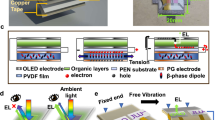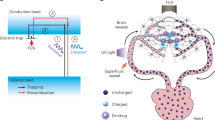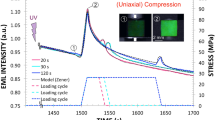Light flashes sparked by acoustic shock waves far outshine those created by manual crushing.
Abstract
Mechanoluminescence, also known as triboluminescence or fractoluminescence, is light emission induced as a result of mechanical action on a solid1,2,3 — for example, Francis Bacon noted as long ago as 1605 that lumps of sugar emitted light when scraped4. Here we elicit mechanoluminescence by a new means, acoustic cavitation, and find intense luminescence and emission lines that are not generated by other mechanisms such as grinding, cleaving, rubbing, scratching, biting or thermal shock.
This is a preview of subscription content, access via your institution
Access options
Subscribe to this journal
Receive 51 print issues and online access
199,00 € per year
only 3,90 € per issue
Buy this article
- Purchase on SpringerLink
- Instant access to full article PDF
Prices may be subject to local taxes which are calculated during checkout

Similar content being viewed by others
References
Chandra, B. P. in Luminescence of Solids (ed. Vij, D. R.) 361–389 (Plenum, New York, 1998).
Walton, A. J. Adv. Phys. 26, 887–948 (1977).
Zink, J. I. Acc. Chem. Res. 11, 289–295 (1978).
Bacon, F. Of the Advancement of Learning (ed. Kitchin, G. W.) (Dent, London, 1915).
Suslick, K. S. & Crum, L. A. in Encyclopedia of Acoustics (ed. Crocker, M. J.) 271–282 (Wiley, New York, 1997).
McNamara, W. B. III et al. Nature 401, 772–775 (1999).
McNamara, W. B. III, Didenko, Y. & Suslick, K. S. J. Phys. Chem. B 107, 7303–7306 (2003).
Walton, A. J. & Reynolds, G. T. Adv. Phys. 33, 595–660 (1984).
Prozorov, T., Prozorov, R. & Suslick, K. S. J. Am. Chem. Soc. 126, 13890–13891 (2004).
Doktycz, S. J. & Suslick, K. S. Science 247, 1067–1069 (1990).
Arora, M., Ohl, C.-D. & Morch, K. A. Phys. Rev. Lett. 92, 174501/1–174501/4 (2004).
Sweeting, L. M. Chem. Mater. 13, 854–870 (2001).
Chandra, B. P. et al. Cryst. Res. Technol. 33, 291–302 (1998).
Author information
Authors and Affiliations
Corresponding author
Ethics declarations
Competing interests
The authors declare no competing financial interests.
Supplementary information
Rights and permissions
About this article
Cite this article
Eddingsaas, N., Suslick, K. Light from sonication of crystal slurries. Nature 444, 163 (2006). https://doi.org/10.1038/444163a
Received:
Accepted:
Published:
Issue Date:
DOI: https://doi.org/10.1038/444163a
This article is cited by
-
Dual-channel mechano-phosphorescence: a combined locking effect with twisted molecular structures and robust interactions
Light: Science & Applications (2024)
-
Contact-separation-induced self-recoverable mechanoluminescence of CaF2:Tb3+/PDMS elastomer
Nature Communications (2024)
-
A mechanoluminescent material, ZnS:Mn,Li, with enhanced brightness for visualizing dental occlusion
Analytical and Bioanalytical Chemistry (2024)
-
Lanthanide-doped metal-organic frameworks with multicolor mechanoluminescence
Science China Materials (2021)
-
Piezoelectricity enhances MoSe2 nanoflowers adsorption of the antibacterial dye malachite green under sonication
Environmental Chemistry Letters (2020)



